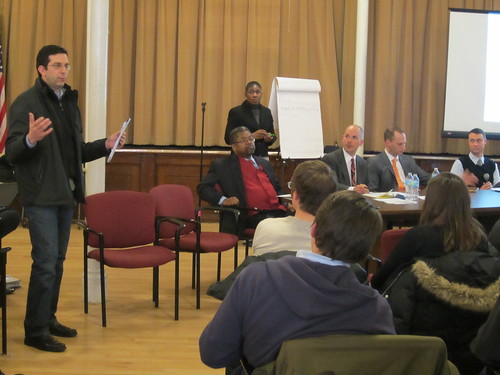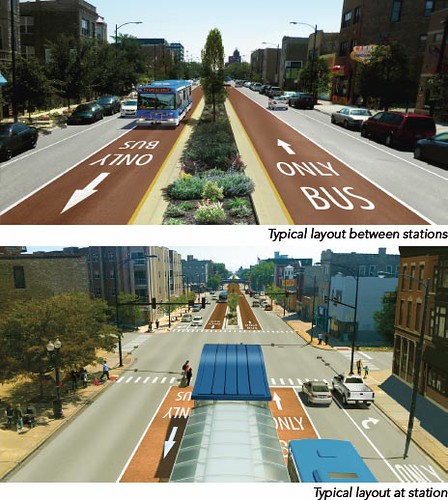The proposal by the CTA and Chicago Department of Transportation to create Bus Rapid Transit corridors along Ashland and Western Avenues promises to speed bus trips for tens of thousands of Chicagoans and spur development. But it's going to take some work to persuade local merchants that better transit is good for their bottom line. A meeting hosted yesterday by the newly formed Ashland Avenue-Western Avenue Coalition, a consortium of five chambers of commerce and community development organizations on the Near West Side, was a case in point. At the forum, as CTA and CDOT staffers outlined the proposal, business owners expressed fears that changes to the roadways would wreck their livelihoods. Few seemed to understand how effective transit and more pedestrian-friendly streets would benefit them.
Four different BRT configurations are being considered for each roadway, with buses running either in the center lanes or curbside, plus different combinations of travel lanes, left-turn lanes, median space and parking removal to make room for the dedicated transit lanes. The design with center-running buses and car-lane removal has earned the endorsement of the Active Transportation Alliance, because it would be the most efficient and ped-friendly option.
In that scenario, bus stations would be placed in the median, curb parking on both sides of the street would largely be preserved, and sidewalks would be widened, while left-turn lanes would be removed. According to CTA studies, this configuration would boost the average bus speed on Western from 10.1 mph to 18.4, with a 50 percent increase in reliability and a 30 percent spike in ridership. Despite the removal of car lanes, the agency predicts average automobile speed would only drop from 17.9 to 16.3 mph.
A series of community meetings was held last fall to update citizens on the Western and Ashland project and ask which of the four proposed configurations they favor. The preferred alternative will be announced this winter, and later this year the CTA will design the routes and conduct environmental impact studies. These routes could be precedent-setting improvements for Chicago transit riders, but not if they get watered down by compromise.
The Ashland Avenue-Western Avenue Coalition tipped its hand a bit with the alarmist punctuation of yesterday’s meeting announcement. “CTA’s proposal to reconfigure these streets may remove curbside parking, for one side of the entire stretch of the addresses above, if not all parking,” it read. In reality, removing parking from both sides of the street is not being actually being considered as an option. “[BRT] would HISTORICALLY RECONFIGURE these streets and HISTORICALLY IMPACT businesses, residents and neighborhoods.” True enough, but the historic reconfiguration of these streets to prioritize transit and walking should be a reason to celebrate, not sow fear.
About 60 people showed up for the afternoon meeting at First Baptist Congregational Church, located at Ashland and Washington, including several alderman and chiefs of staff. Joe Iacobucci, the CTA’s manager of strategic planning and policy, CDOT deputy commissioner Scott Kubly and Chris Ziemann, the city’s BRT manager outlined the reasoning behind the proposed changes. “For the last 50 or 60 years roadways were designed with the automobile as the primary users,” Kubly said. “Transit, pedestrians, and cyclists played second fiddle. And what we’re trying to do as a department is look at all the new road projects that we’re doing and accommodate all the users.”
Louis Rago, owner of Rago Brothers Funeral Home, located nearby at Western and Erie, said he was opposed to any parking loss on the street. “We depend upon the parking that’s available on the side streets and on Western,” he said. “So you’re concerned about getting these people to where they want to go. We’re not going to be there for them. You’re going to put us out of business.” Iacobucci pointed out that half of the alternatives preserve nine out of ten on-street parking spaces. “Nine out of ten spaces? Gee whiz!” responded Rago sarcastically. The business owners present generally seemed unclear on the concept that BRT would significantly boost bus ridership, which would mean less need for car parking.
Another woman argued that removing the left-hand turn lanes would wreck her business by impeding deliveries. While truckers could alter their routes slightly to eliminate left turns off of these roads, she painted the restrictions as catastrophic. “If you take away the left-hand turn lanes, that means the semis cannot come into my business,” she insisted. “If my semis can’t come in, we’re out of business. So now you won’t have to worry about getting people to their jobs [by bus] because they’ll have no jobs to go to.”
Such statements were typically greeted by a chorus of approval from the other business owners present, but these skeptics should head over to Euclid Avenue in Cleveland if they don't believe BRT could bring more people and jobs to Western and Ashland. There, the center-running HealthLine BRT system has boosted ridership and attracted a wave of new development, with $3.3 billion being invested in new construction and $2.5 billion for building rehab.
But it wasn't all opposition at yesterday's meeting. Burt Klein, president of PortionPac, a cleaning supply company at Ashland and Kinzie, said he’s open to creating a better way to get his employees to work car-free. “We’ve got bikers, walkers, people taking the train, taking the bus, taking Metra, or an assortment of those things,” he said. “We also have a nice, big parking lot, and when the price of gas goes up our parking lot gets kind of empty. But the [employees] that we’re attracting, either to the north of us or to the south of us, very few of them take the Ashland bus right now because it’s so slow.”
Kubly made a convincing argument why the status quo on Ashland and Western won't work in the future. “We have a finite amount of roadway in the city,” he said. “We’re not going to be widening roads because that would mean taking out people’s houses. So if you want to reduce traffic [congestion] you’ve got two choices. You can reduce the number of people living, working and being active in the city, or you can try to figure out ways to get people out of their cars, walking and biking and taking transit.”





